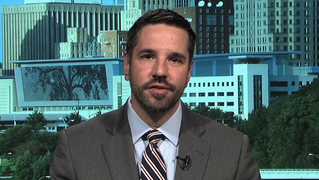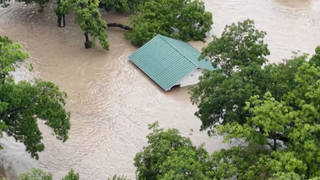
Topics
Guests
- Aaron Glantzreporter for the Bay Citizen, a part of the non-profit Center for Investigative Reporting. He is also the author of three books, most recently, The War Comes Home: Washington’s Battle Against America’s Veterans.
- Bonnie Carrollpresident and founder of the Tragedy Assistance Program for Survivors, or TAPS. She recently co-chaired the Department of Defense Task Force on the Prevention of Suicide in the Armed Forces.
- Kevin Hinessurvivor of attempted suicide, public speaker, mental health advocate, forthcoming author of Cracked…Not Broken: The Kevin Hines Story. He acts as a peer counselor to many military servicemen and women who suffer from suicidal thoughts and other mental health issues.
More U.S. soldiers have died this year by taking their own lives than on the battlefield. The Pentagon says there have been at least 154 suicides among active-duty troops in 2012, a rate of nearly one each day. We’re joined by three guests: Kevin Hines, who survived a jump off the Golden Gate Bridge in San Francisco and now counsels suicidal soldiers; Bonnie Carroll, co-chair of the Pentagon’s Task Force on the Prevention of Suicide in the Armed Forces and president of the Tragedy Assistance Program for Survivors; and journalist Aaron Glantz, author of the book “The War Comes Home: Washington’s Battle Against America’s Veterans.” [includes rush transcript]
Transcript
NERMEEN SHAIKH: New figures show this year’s military suicide rate is on pace to reach a record high. The Pentagon says there have been at least 154 suicides among active-duty troops through last Thursday, a rate of nearly one each day. The figure marks an 18 percent increase over the same period a year ago. More U.S. soldiers have died by taking their own lives than on the battlefield.
The reasons for the increase in suicides are not fully understood. Among explanations, studies have pointed to combat exposure, post-traumatic stress, misuse of prescription medications, and personal financial problems. Army data suggest soldiers with multiple combat tours are at greater risk of committing suicide, although a substantial proportion of Army suicides are committed by soldiers who never deployed.
Democracy Now! recently spoke to Iraq War veteran Aaron Hughes about suicides in the military community.
AARON HUGHES: Every day in this country 18 veterans are committing suicide. Seventeen percent of the individuals that are in combat in Afghanistan, my brothers and sisters, are on psychotropic medication. Twenty to 50 percent of the individuals that are getting deployed to Afghanistan are already diagnosed with post-traumatic stress disorder, military sexual trauma or a traumatic brain injury. Currently one-third of the women in the military are sexually assaulted. It’s clear that these policies of the global war on terror has had a profound effect on the military, my brothers and sisters, while simultaneously perpetuating a failed policy. And unfortunately, we have to live with that failed policy on a daily basis, and we don’t want to be a part of that failed policy anymore.
AMY GOODMAN: That was Aaron Hughes, field organizer for Iraq Veterans Against the War, who helped plan the NATO protests in Chicago last month.
For more, we’re joined by three guests. In San Francisco, Aaron Glantz is with us, reporter for The Bay Citizen, a part of the non-profit Center for Investigative Reporting, author of three books, most recently, The War Comes Home: Washington’s Battle Against America’s Veterans.
We’re also joined by Kevin Hines. As a teenager, he attempted suicide by jumping off the Golden Gate Bridge in San Francisco, went on to become a mental health advocate and is author of the forthcoming book, Cracked…Not Broken: The Kevin Hines Story. He is a peer counselor to many soldiers and veterans who suffer from suicidal thoughts.
And in Washington, D.C., we’re joined by Bonnie Carroll, president and founder of the Tragedy Assistance Program for Survivors, or TAPS. She recently co-chaired the Pentagon’s Task Force on the Prevention of Suicide in the Armed Forces.
Carroll, let’s begin—Bonnie Carroll, let’s begin with you. Can you talk about the figures? Astounding, more soldiers are committing suicide than die on the battlefield.
BONNIE CARROLL: Yes. TAPS is the national organization for all those who have lost a loved one serving in the armed forces, and we actually see even a greater number, because we’re working with families who have lost a loved one to suicide, possibly not in a duty status, Guard and Reserve members who have come back and died by suicide during the week or in an off period. We also see those families who have lost a loved one to suicide after their loved one recently got out of the military. So, every death is absolutely tragic. And what we’ve been able to do is gain insight for the families to help with prevention efforts.
AMY GOODMAN: I want to turn to Mary Kirkland. She is the [mother] of Derrick Kirkland. Derrick joined the Army in 2007, since he wasn’t earning enough money to support his wife and child. During his second deployment to Iraq, he attempted suicide for the first time. I met Mary Kirkland in Chicago at the NATO protest where U.S. soldiers, veterans, threw their medals, their war and service medals, back at the NATO generals, towards the gate of the NATO summit and handed Mary Kirkland a flag, a U.S. flag, in honor of her dead son. Here she describes what happened to Derrick when he returned from Iraq.
MARY KIRKLAND: He met with a psychiatrist the next day who deemed him to be low to moderate risk for suicide, his only restriction being that he was not to be around any weapons, and cleared him for him to go basically in the barracks room by himself, which I found, after talking to the veterans, was illegal.
He tried to kill hisself again on Thursday night. He got back on the 15th and killed himself on the 19th. On the Thursday, on the 18th, he had bought some rum, so was drinking rum with his medications that they did just gave him, his antidepressants and sleep medicine, and cut hisself, had bloodstains all over his room. It wasn’t successful, so he got up Friday morning and bandaged hisself.
One of his things that he wrote before he went and hung hisself was “I feel invisible. I feel like I’m transparent.” And nobody walked into the room on Friday to see the bloodstains. Derrick didn’t hang hisself until—the last time they had seen him was Friday night at 10:00, and they found him Saturday morning at 1:30. If anybody would have walked in that room on that Friday—but they didn’t even—the leadership wasn’t even checking on him.
So this mother got woke up Sunday morning at 6:30 to tell me that my son was dead, that I had let my guard down, 'cause he got back on Monday, he's back in the United States, he’s safe, he’s—and the Army called it a “miscommunication,” is why my son is dead.
AMY GOODMAN: That’s Mary Kirkland describing the suicide of her son, Derrick Kirkland, who had put a gun in his mouth in Iraq. He was sent to a hospital in Germany, then sent home to Fort Lewis-McChord, where he was put into the hospital and, as she described, let out, saying that he had low risk of suicide. He committed suicide the next day, on March 19, 2010, after two tours of duty in Iraq.
Aaron Glantz, you have done a lot of research on soldier suicides. Can you respond to what happened to Derrick and put it in the broader context not only of soldiers, but of veterans, as well?
AARON GLANTZ: Yeah, I mean, unfortunately, there’s many, many stories like that. I wrote a few years ago about a Specialist John Fish of San Luis Obispo out here in California. He served a tour in Iraq. He was suicidal. He told his commanders he was suicidal when he was in Iraq. He came back to the United States, and they told him to just start training to go to Afghanistan. And during the training exercises, he walked out into the desert outside El Paso, and he shot himself in the head with a military-issued weapon.
We’ve been at war for 10 years. We have 2.5 million Americans who have served in these wars. About a million of them are still in the military, and a million and a half of them are out of the military and are now veterans. We have 18 veterans who commit suicide every day in this country. We haven’t asked people to go through war in this kind of way, you know, probably since World War II. In Vietnam, people served one tour, and then they came home. We had a draft. Now we ask people to go again and again. And so, you have a million people who have been through the wars who are still in the military. You have 90,000 people who are still in Afghanistan fighting this war. It’s not surprising that the suicides would be higher than the battlefield deaths at this point.
NERMEEN SHAIKH: Kevin Hines, can you talk a little bit about your work with the military and your own experience of attempted suicide?
KEVIN HINES: Absolutely. I attempted suicide on September 25th of the year 2000 by way of jumping off of the Golden Gate Bridge, the single-worst decision of my entire life. But I made it because I was not of my right mind. I was very sick and ill with bipolar disorder, which was plaguing me and causing me great self-destruction.
And so, what I do now, and what I’ve done for the last 11 years, is travel the country and internationally speaking about suicide prevention to all groups, but I greatly appreciate being able to talk to any group of military servicemen and women and their commanding officers. It’s very important to me to reach out to them, and I have done so the past 10 years, probably two weeks or even three weeks out of the year, dedicated to military bases and Veterans Affairs hospitals and areas in—
Look, we’ve got to trend down these rates, and we’ve got to do it now. I’m of the opinion that, you know, we’ve spent over $720 billion on the Iraq war, and it’s just—the number keeps adding up every day. We need to spend a fraction of that on mental health in the military. You know, sometimes you go to a base that has one psychiatrist per 5,000 to 10,000 servicemen and women. That needs to be one per every 10, so we can adequately help these individuals and aid them to safety, and so they can stay in the military, do their service, and do good for this country. They can’t do that when they’re not well. And we can’t keep sliding it under the rug. Something needs to change.
NERMEEN SHAIKH: Well, some people have suggested that the reason that suicides are so high is because soldiers are discouraged from admitting to any kind of problem. Bonnie Carroll, I want to ask you about a recent controversy involving Major General Dana Pittard, a commander at Fort Bliss. Last month, he wrote on his blog, quote, “I am personally fed up with soldiers who are choosing to take their own lives so that others can clean up their mess. Be an adult, act like an adult, and deal with your real-life problems like the rest of us.” The posting was retracted, but Pittard never apologized. He still commands one of the Army’s largest units. Bonnie Carroll, your response?
BONNIE CARROLL: I met with the director of the Army staff actually that day, and I can tell you that is not the sentiment shared by Army leadership, and it certainly isn’t the sentiment shared by the leadership across the armed services. General Pittard is a good man, and that was a very, very unfortunate statement that was made, and I’m grateful that he has retracted it.
What we’ve seen across the services is a transformation in culture. The Marine Corps has done an extraordinary job of transforming boot camp training so that, right in the first two weeks of that recruit training, these young marines are told that suicide is a potential in their lives, that they may become so surrounded by challenges that they may become desperate and feel that their own death is the only way out. They equate that to what a warrior may experience in combat when they’re surrounded by the enemy. And they normalize help-seeking behavior, saying, you know, “This is what warriors do. This is what marines do. We seek help when we’re surrounded by challenges.” And then they go on to say, “This is what that help looks like. It’s going to your buddy. It’s going to the chaplain. It’s telling your first sergeant or your commander.” And then what they’ve done is transform the leadership to really embrace those who come forward and, again, you know, as Kevin was saying, bring them in tight and let them know that their life is valuable and that they’re going to be back on track, there is help and a support available. We’ve seen a 10 percent drop in suicide in the Marine Corps because of this program. I just want to commend the commandant for extraordinary work in this regard.
AMY GOODMAN: Aaron Glantz, do you see that kind of transformation in the military right now?
AARON GLANTZ: Yeah. I mean, I have seen a lot of effort on the part of the military over the last few years. There have also been generals who have come forward and said that they have post-traumatic stress disorder. And that does a tremendous amount to reduce the stigma of their enlisted personnel coming forward and seeking help. But, as Kevin was saying, there’s not nearly enough resources, and the amount of accumulated trauma that these soldiers, marines and airmen are experiencing, because of the war itself, continues to accumulate the longer the war goes on, and the military is playing catch-up.
AMY GOODMAN: And the classifications of people having post-traumatic stress, the tremendous problem there’s been in the past of denying soldiers who have returned and veterans support and help for PTSD, Aaron?
AARON GLANTZ: Yeah, definitely, that’s been a problem. And the military has had a problem of discharging those people under, quote-unquote, “personality disorder” rather than giving them a medical discharge for the mental wounds they have received in the war. So then they get out and they’re veterans, and they have difficulty accessing the veterans’ healthcare system. These issues, which were pointed out under the Bush administration, have begun to be remedied, to some extent, in the Obama administration, but the problems persist.
NERMEEN SHAIKH: But if there have been—if there’s been such a transformation in the military culture with respect to mental problems, why has the rate of suicide gone up so much in this year, in 2012, relative to 2011 and 2010?
AARON GLANTZ: Well, I don’t think that it should be surprising that the suicide rate would increase, if we look at the fact that the number of soldiers who have gone through the war has increased and, as Kevin was pointing out, the amount of resources available to returning soldiers continues to be insufficient to meet that need. We also have, you know, I might say, you know, as Aaron Hughes, the Iraq War veteran who began this segment, large numbers of soldiers still deploying to the wars who have actually served previous tours and are deployed on psychotropic medications to Afghanistan. I mean, just imagine you’re holding an M-16 or another, you know, military-issued firearm, you have a scary situation all around you, and you’re on drugs that affect your ability to respond to certain situations. It’s a very difficult situation. But I didn’t want to undermine what Bonnie was saying, which is that the military has done a tremendous amount in recent years. But we see the evidence in the rising suicide rate that it has not actually solved the problem.
AMY GOODMAN: Kevin Hines, as a suicide survivor yourself, though you weren’t in the military, your grandfather committed suicide coming back from Okinawa, and now you’ve counseled many soldiers with suicidal thoughts, what’s the single most important thing you feel needs to happen?
KEVIN HINES: Single most important thing I feel needs to happen is very simple. The government—somebody needs to fund mental health for the entire—every military sector. We need to reach out to these individuals on a broader basis. They need to have more therapists, more psychiatrists on hand, more chaplains. And we need to have the ability, like the Marines are doing—and they’re doing it, and they’re doing it well—
AMY GOODMAN: Kevin Hines, we’re going to have to leave it there. I want to thank Kevin Hines, Aaron Glantz and Bonnie Carroll for joining us.













Media Options